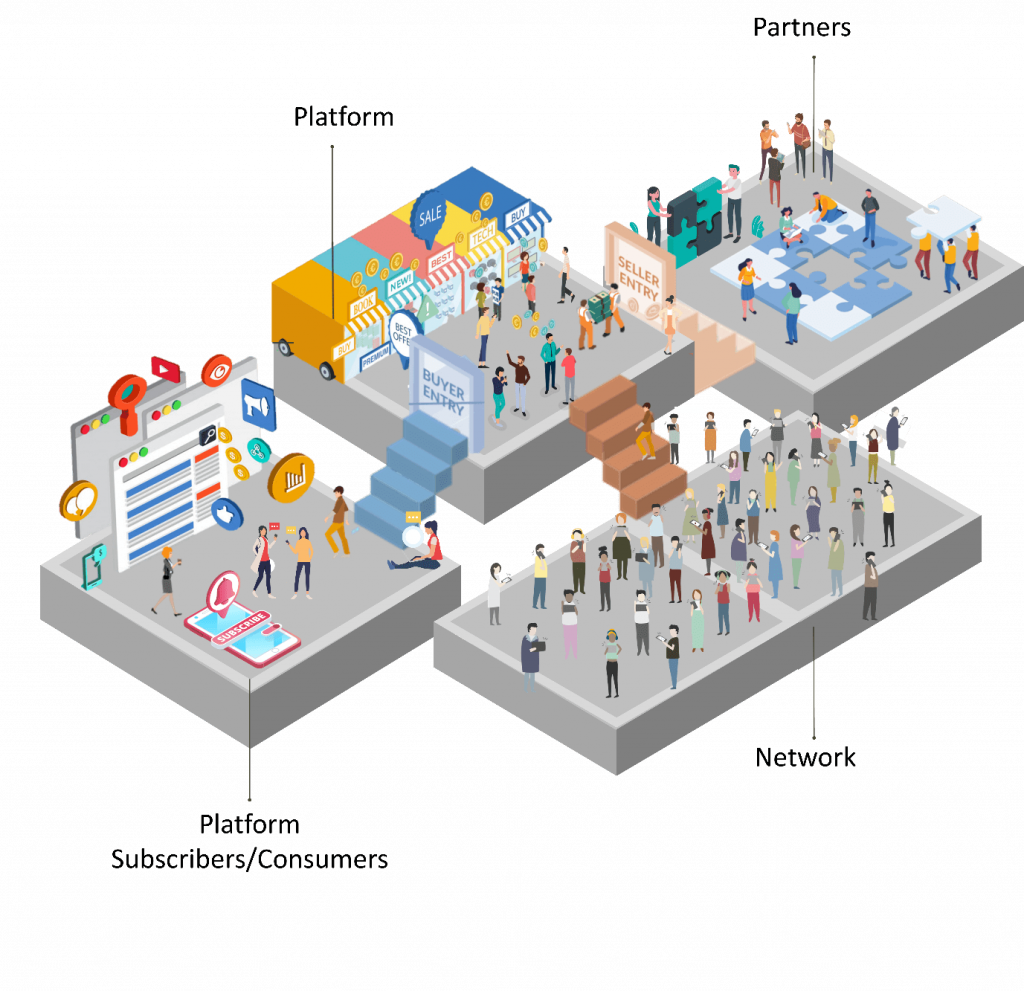The corporate giants of the industrial era were able to dominate their markets by making more – and convincing consumers to buy more.
As production soared, they drove efficiencies to improve margins. By creating more supply, they were able to spread costs over larger volumes, charge less and invest more in distribution and marketing. In doing so, it created formidable barriers to entry and helped them secure a strong market position amongst their competitors.
Of course, scale remains critical to the creation of market leaders today. But the nature of that scale is changing. Competitive advantage now comes, not from maximising the volume of product or service provided, but by bringing vast numbers of like-minded participants together in networks.
Investors, and the management teams they back, must embrace this transition from the bilateral exchange of goods and services, and aspire to become orchestrators of ecosystems – or platforms. Indeed, platformisation is becoming essential to business survival in the digital age.
What is platformisation?
The concept of platformisation is nothing new. The Amazon model, for example, is little different to a car boot sale, where stall holders pay a fee to set up and interact with visiting shoppers. But the digital age has witnessed an explosion of these online platforms, able to leverage technology to meet escalating consumer demands for speed, interactivity and the personal touch.
Platforms have long existed in the B2B space and are gradually starting to become more prevalent in the B2C space. It is no longer just about connecting buyers and sellers – as Alibaba does with e-commerce, as Netflix does with viewers and films or booking.com does with hotels. Traditional companies will only survive the tsunami of market disruption they are facing if they are able to transcend the linear exchange of goods and services, creating a holistic ecosystem around their industry, where market participants are both producers of demand and consumers of supply.

Why platforms win
There is, after all, no denying the potency of the platform. The top 15 publicly quoted platform companies currently represent over $2.5trn in market capitalisation, dwarfing more linear B2B and B2C models.1
Platforms are able to grow faster and more efficiently than traditional businesses because they do not have to manufacture the additional products or services themselves. Some, or all, of that expansion comes from the platform’s network of users, with limited requirement for investment in the infrastructure of the business beyond that to build and manage the platform itself.
Of course, there are overheads. Uber, for example, employs teams to carry out driver checks. But, by and large, growth is not tied to human or organisational factors and so the cost of serving an additional user is negligible, making it inherently easier to scale.
Platforms are also able to exploit what is known as the network effect. This simply refers to the way in which the value of the platform to market participants increases disproportionately the more market participants there are. Facebook, for example, provides greater value to users the more potential connections it offers – currently over a billion.
Furthermore, a successful platform will create high barriers to entry as the platform owner becomes the market owner and orchestrator. It is very difficult for a taxi company to go up against Uber in a city where it already exists. Platformisation is a powerful way to build sustainable market dominance.
From product to platform
Of course, creating and maintaining a vibrant ecosystem of market participants is no simple task – or everyone would be doing it. Thriving platforms work hard to first build and then nurture their networks. Creating trust systems is key, as is ensuring frictionless functionality.
Building a platform from scratch, in particular, is incredibly difficult. Size is essential and so upfront costs are potentially huge. Most companies begin, instead, with a linear concept and build a platform over time.
Even Amazon started out with a core book retail proposition. Apple, meanwhile, created the iPhone, before opening an app store to foster an ecosystem. Today that app store hosts more than 2.2 million applications. Other businesses to have successfully evolved from existing product and service lines to platform delivery include Salesforce and Shopify.
Indeed, for companies with a strong foundation, large or high-value audiences and excellent functionality, the opportunity to transition from simple buy/sell relationships to a platform is one of the most transformative and value-creating growth journeys they can embark on.
Instead of simply focusing on optimising existing business models, ambitious management teams – and their investors – must aspire to elevating themselves above traditional linear industry dynamics to create, rather than participate, in the marketplace. Platforms will overwhelmingly dominate in the digital era and whoever gets there first will win.



